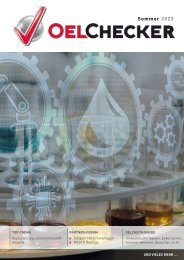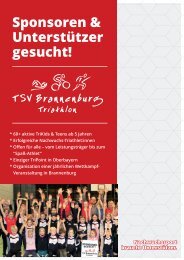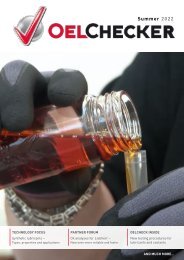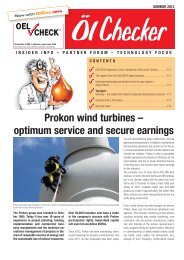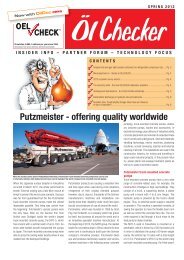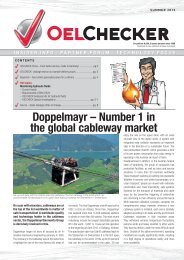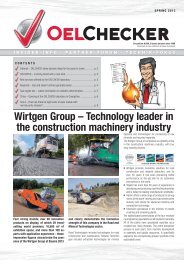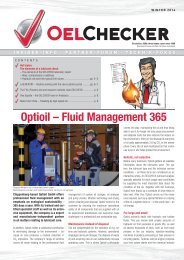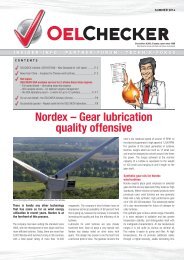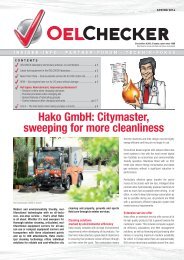OELCHECKER - Winter 2012
> OELCHECK China – Getting ready before the new laboratory opens > OELCHECK Laboratory – quicker and more accurate with a new particle counter > Hot Topics: The analysis of lubricating greases > Correct sampling > Most important analysis methods > Experience of our experienced tribologists > In demand – optimising online documentation of laboratory reports > and much more...
> OELCHECK China – Getting ready before the new laboratory opens
> OELCHECK Laboratory – quicker and more accurate with a new particle counter
> Hot Topics: The analysis of lubricating greases
> Correct sampling
> Most important analysis methods
> Experience of our experienced tribologists
> In demand – optimising online documentation of laboratory reports
> and much more...
You also want an ePaper? Increase the reach of your titles
YUMPU automatically turns print PDFs into web optimized ePapers that Google loves.
HOT TOPICs:<br />
OELCHECK TECHnOLOGY fOCUs<br />
The analysis of lubricating greases<br />
What lubricates more efficiently, oil or grease? Over 95% of all components are lubricated with oil, not because it lubricates better<br />
but because it has a wider variety of characteristics. Grease is generally only used if oils cannot be used because sealing the<br />
lubrication point is problematic or expensive. Typical cases of where lubricating greases are applied are rolling bearings, around<br />
80% of which are lubricated with grease. during the analysis of used lubricant, oils and grease behave similarly. Both contain<br />
important information; however, it is more difficult to decode the results for greases. OELCHECK carries out over 5,000 lubricating<br />
grease analyses per year and is thus the world‘s leading lubricating grease laboratory. Our laboratory does not just have specific<br />
testing measures and testing devices – experienced engineers are also on hand to interpret the values. The analysis is done with<br />
low-cost analysis kits which can be complemented by special additional studies.<br />
Greases contain lubricating oils with additives,<br />
which are integrated in a sponge-like structure<br />
of „soap“ or „thickener“ so that there is no run-off.<br />
According to DIN 51 825, „lubricating greases [are]<br />
consistent lubricants which consist of mineral oils<br />
and/or synthetic oils as well as a thickener.“ The<br />
thickeners predominantly used are metallic soaps<br />
such as lithium, calcium, aluminium, barium and<br />
sodium soaps as well as their complex soaps. Gels,<br />
polyurethanes and bentonite are also used. The<br />
sponge-like structure arises when the original material,<br />
which is mostly in powder form, is brought<br />
to the boil with water. The water which evaporates<br />
during the boiling process is continuously replaced<br />
with oil. Additives are added during the cooling<br />
phase. Before filling the grease is ground and<br />
homogenised. Air which has entered the grease<br />
is also removed at this point. A multi-purpose<br />
grease consists of up to 92% oil. The lubrication<br />
is mostly carried out with base oil and its additives.<br />
The thickener on the other hand does not just<br />
prevent oil run-off, but constantly provides oil to<br />
the lubrication points.<br />
Correct sampling<br />
With lubricating greases in particular, correctly<br />
drawing off a representative sample is a pre-condition<br />
for qualified analysis and reliable diagnosis.<br />
OELCHECK offers a professional tool, the „Grease<br />
Sampling Kit“, to collect used grease samples.<br />
OELCHECK - Grease Sampling Kit<br />
An OELCHECK Grease sampling Kit includes:<br />
A large-volume, reusable syringe. In this way<br />
the grease sample can be drawn from a lubricating<br />
hole using transparent tubing, which is<br />
included in every Grease Sampling Kit.<br />
Different plastic spatulas.<br />
An alternative method to collect lubricant<br />
grease from relief wells, difficult-to-reach storage<br />
areas and unusual components, or from<br />
the seal lip area.<br />
Cleaning cloth – used to clean the surroundings<br />
of the extraction site, to remove the excessive<br />
grease and if need be to wash your hands.<br />
Sample containers, lubrication sample information<br />
form and a pre-addressed envelope. The<br />
sample container has room for the tube with<br />
the sample inside or the spatula with the grease<br />
that has been extracted. The sample information<br />
form should be filled out completely and<br />
sent to OELCHECK laboratory in the pre-addressed<br />
envelope.<br />
sample amounts and basic rules<br />
• Depending on the questions you need answered<br />
and the scope of the analysis, analysis can take<br />
place once there is 1g of fat available (2 cm of<br />
fat in the tubing) With a full tube (8-10 g), almost<br />
all the analyses which are summarised in the<br />
Grease Sampling Kit can take place.<br />
• Always take the specimens for trend analyses<br />
from the same place!<br />
• Ideally, you should provide us with a fresh grease<br />
sample for reference purposes.<br />
• The sample will be more representative if the<br />
grease has been mixed again using a slow turning<br />
movement before the sampling.<br />
• Ensure via visual inspection (dark colouration in<br />
the tubing) that you extract used grease only.<br />
You can download practical tips and detailed<br />
instructions on how to take grease samples<br />
correctly at the download section of<br />
www.oelcheck.de.<br />
Grease analyses in the OELCHECK<br />
laboratory<br />
We offer different kits to analyse grease. Further<br />
complementary tests are also available. The engineers<br />
at OELCHECK can advise you on the selection<br />
of the analyses you require and the most<br />
suitable analysis kits. This does not just take the<br />
kind of lubricant grease and its use into account;<br />
the reasons for the analysis are also discussed.<br />
OELCHECK grease analyses can among other<br />
things contribute to:<br />
• Optimisation of lubricant amounts and re-lubrication<br />
intervals<br />
• Detection of impurities and mixing with other<br />
types of grease<br />
• Prove bearing wear and identify its causes<br />
• Distinguish between corrosion and mechanical<br />
wear<br />
• Provide early warning against ageing and grease<br />
alterations<br />
Analysis kits for lubricating grease<br />
Any kit with a higher number will include the<br />
range of analyses found in the preceding kit. Kit 1,<br />
for example, provides information about wear,<br />
additive decomposition and stubborn impurities<br />
based on approximately 30 values. If the sample<br />
amount is sufficient we recommend the range of<br />
analyses included in kit 5.<br />
Kit 1<br />
Kit 2<br />
Kit 3<br />
Kit 4<br />
Kit 5<br />
Wear metals: Iron, chrome, tin, aluminium, nickel,<br />
copper, lead and molybdenum<br />
Additives: Calcium, magnesium, zinc, phosphorus,<br />
barium, boron<br />
Impurities: Silicon, potassium, sodium<br />
Kit 1 + PQ Index, basic oil state (FT-IR)<br />
Kit 1 + KF water<br />
Kit 1 + residual oil content<br />
Kit 1 + Penetration




